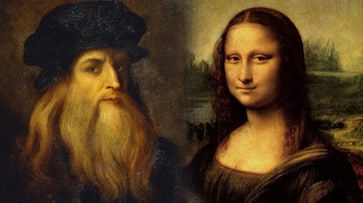The condition of strabismus is thought to be an advantage to painters as it lets them focus better and has been identified in other well-known artists, including Rembrandt.
Researchers from the Optometry and Vision Sciences School at the City University of London have come to a conclusion that the greatest painter Leonardo da Vinci probably used the squint in his eye in creating his masterpiece, the Mona Lisa’s smile.
Doctors have studied the Renaissance master with strabismus (common vision disorder where one of the eyes looks inward) after analysing the eye alignment of his works, which are believed to have been modelled, in part, on himself.
The condition of strabismus is thought to be an advantage for painters as it lets them focus better on close-up flat surfaces and has been identified in some well-known artists, including Rembrandt.
Leonardo's text, the Codex Atlanticus, says that artists can't help but be self-inspired: “[The soul] guides the painter’s arm and makes him reproduce himself since it appears to the soul that this is the best way to represent a human being."
"A number of famous artists have been identified as having strabismus on the basis of the eye alignment evident from their self-portraits, including Rembrandt Harmenszoon van Rijn, Albrecht Dürer, Giovanni Francesco Barbieri, Edgar Degas, and Pablo Picasso," the study’s author, neuroscientist professor Christopher Tyler, said.
Artistic work by subduing the deviating eye, which forms two-dimensional monocular vision, is advantageous when it comes to painting and drawing. While having two eyes focused on an object (stereoscopic image) is integral to our depth perception, it can make translating three-dimensional scenes to canvas more tricky, as each eye will be seeing objects slightly to the right or left.
In the research published in JAMA Ophthalmology, professor Tyler measured the alignment in six artworks including two drawings, two oil paintings and two sculptures believed to be partly self-inspired by fitting circles to the irises of each eye and measuring the average deviation from alignment.
In all cases, the eye misalignment was measurable, though not severe, and averaged at a 10.3° deviation from the focused eye across the six pieces.
This negative number means the eye would tend to look outwards (exotropia), and professor Tyler argued that Da Vinci's strabismus may have been non-existent when focusing intently on an object, but would have come into existence while relaxing as he paints. This would give him the best of both worlds.
“The weight of converging evidence suggests that Leonardo had intermittent exotropia, with a resulting ability to switch to monocular vision. This would perhaps explain his great facility for depicting the three-dimensional solidity of faces and objects in the world and the distant depth recession of mountainous scenes,” professor Tyler said.
Last Updated Oct 22, 2018, 1:40 PM IST









![Salman Khan sets stage on fire for Anant Ambani, Radhika Merchant pre-wedding festivities [WATCH] ATG](https://static-gi.asianetnews.com/images/01hr1hh8y86gvb4kbqgnyhc0w0/whatsapp-image-2024-03-03-at-12-24-37-pm_100x60xt.jpg)
![Pregnant Deepika Padukone dances with Ranveer Singh at Anant Ambani, Radhika Merchant pre-wedding bash [WATCH] ATG](https://static-gi.asianetnews.com/images/01hr1ffyd3nzqzgm6ba0k87vr8/whatsapp-image-2024-03-03-at-11-45-35-am_100x60xt.jpg)


